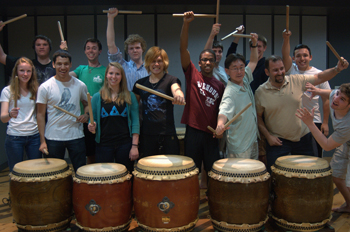American undergraduates soak up culture, research in summer journey
The lasting image of tsunami-torn Minami-Sanriku for Raymundo Moya ’17 was one of contrasts. Older residents seemed sad and young children were exuberant and playful in their interactions with students visiting as part of the Rice University-led NanoJapan: International Research Experience for Undergraduates program.

Rice students Raymundo Moya (front, second from left), J.J. Allred (back, third from left) and Dante Zakhidov (back, far right) take part in a Taiko drum lesson, part of NanoJapan cultural training in Japan earlier this summer.
The devastation is hard to take in, Moya said. “You can see the older men are hurt inside. You can see the pain, what they’re going through. And you can see the happiness in the children running around. It’s just another day for them. It’s kind of weird to see that, but on the other hand, it’s hopeful,” he said.
Moya and two other Rice students were among 12 who visited the northeast coastal town of Minami-Sanriku. The once-thriving resort of 19,000 was largely destroyed, and more than half its population likely killed, in the tsunami that followed the Tohuku earthquake in March 2011. The American students volunteered to work with children there for a day as part of their immersive training in Japanese culture.
NanoJapan is in its eighth year. Led by Junichiro Kono, a Rice professor of electrical and computer engineering and of physics and astronomy, the program brings undergraduates from American universities to Japan, where they are immersed in Japanese culture and language for three weeks before reporting to labs at universities for eight-and-a-half weeks of intense nano-based research. (In 2011, the program brought Japanese and American students to Rice in the wake of the tsumani.)

Rice student Raymundo Moya works with students in a Japanese elementary school as part of NanoJapan.
Moya, a rising sophomore at Rice, was making his first trip outside of Texas. Everything about the journey represented a new experience. “It was a big jump,” he said. But Moya had two NanoJapan companions at Tohoku University, where he studied the physics behind phonon heat transfer in carbon nanotubes. “The three of us were always together, so our Japanese kind of fell apart when we were there,” he said.
Traveling to Japan was a homecoming of sorts for Dante Zakhidov ’15. Zakhidov’s scientist father had spent time working and living in Japan with his young family. “My dad did some of his pioneering research in Japan,” said Zakihidov, who was there for a year as an infant. “He worked on using C60 (buckyballs) as a dopant for conducting polymers. I have no memory of living there, but it was great to go back.”
Zakihidov studied new techniques to activate graphite for lithium ion batteries during his three-week stint at Shinshu University. And he thoroughly enjoyed his time with the rest of the NanoJapan team. “There were so many activities that pushed the 12 of us together,” he said. “We fully developed and bonded. That’s what’s powerful about the program: You have a network to fall back on.”

Rice student J.J. Allred and a friend in Japan earlier this summer. Three Rice students took part in the program that brings American undergraduates to Japan for six weeks of cultural and language training and research.
J.J. Allred ’16 is looking forward to a two-week break before classes, but given the choice, “I’d rather be in Japan,” he said. The rising sophomore studied the reaction of graphene to terahertz radiation during his time at Osaka University. “When the program ended, I had discovered something that blossomed into four or five other things to look into,” he said. “Hopefully, this fall I’ll be able continue working on it with Dr. Kono.”
All the students kept a week-by-week log of their experiences, and the logs have been posted online at the NanoJapan site. Along with the Rice students, this year’s program included students from Carnegie Mellon University, the University of Dallas, Northern Arizona University, Southern Illinois University, Northwest Vista College, Brown University, Morehouse College, the University of Florida and the University of Tulsa.
The program, funded by a National Science Foundation (NSF) Partnerships for International Research and Education (PIRE) grant, contributes to the development of a generation of globally competent scientists and engineers.
The students presented the results of their studies at the U.S.-Japan Symposium on Global Scientist Education through Research Partnerships, held in Tokyo July 29.
Co-organized by Kono and his PIRE collaborator, Professor Masayoshi Tonouchi of Osaka University, the symposium highlighted the research and educational accomplishments of the TeraNano Center/PIRE U.S.-Japan partnership and hosted talks by distinguished speakers that included Edward Murdy, director of the NSF-Tokyo office, Hiroyuki Sakaki, president of Toyota Technological Institute, and Morinobu Endo, a professor at Shinshu University.
The students returned to Rice July 31 for a two-day re-entry that included workshops by the Rice Center for Written, Oral, and Visual Communication, the Rice Center for Career Development and the Office of Fellowships and Undergraduate Research. Students also toured nanotechnology labs at Rice and learned about the Rice Applied Physics Ph.D. program and applying to graduate school.
They also presented a research poster on their summer projects at the Rice Quantum Institute’s summer research colloquium Aug. 2.


Leave a Reply